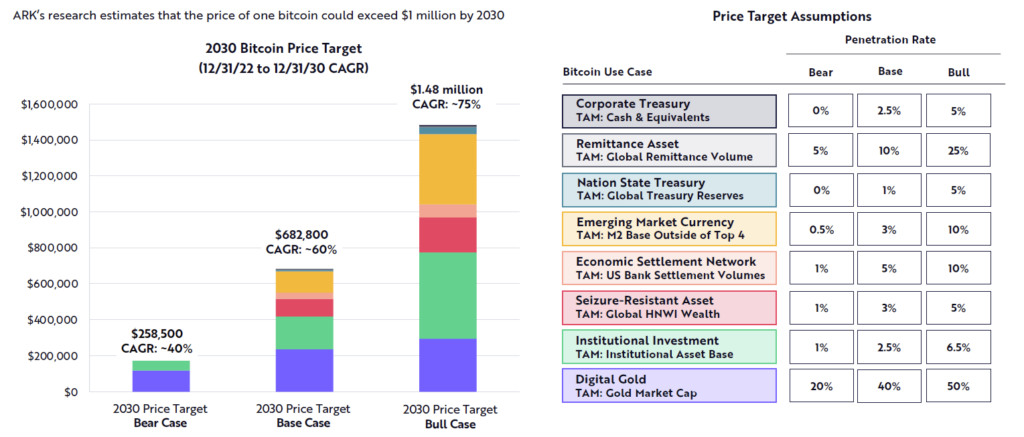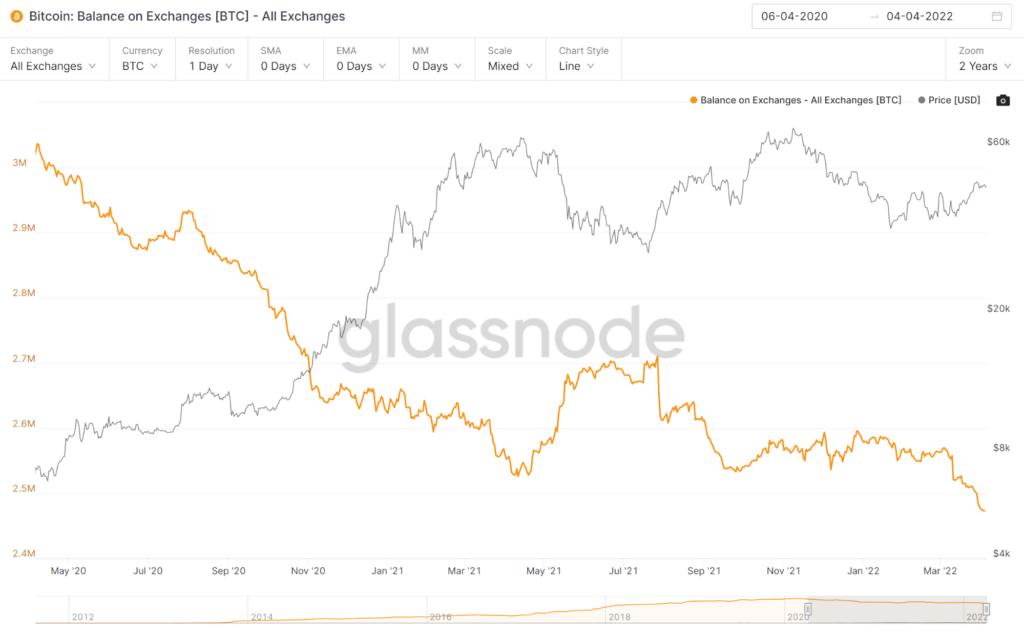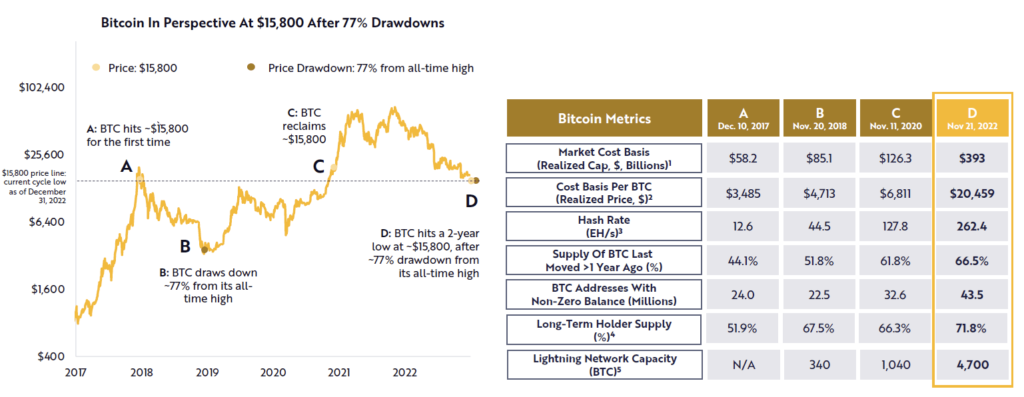ARK Investment Management recently released a comprehensive report suggesting bitcoin is likely to scale into a multi-trillion dollar market. The report analyses different metrics of the bitcoin network and emphasizes the resilience and durability of bitcoin, highlighting its strengthening long-term prospects.

Source : Ark Investment Management
Notably, it put forward a speculation that the price of a single bitcoin could exceed $1 million in the next decade. This optimistic outlook presents an enticing opportunity for potential investors, indicating a promising future for bitcoin.
Despite this year’s ups and downs, bitcoin has remained unwavering, with its network fundamentals becoming more robust and its user base increasingly focused on long-term investment.
The rise of centralized counterparts and their associated risks have further highlighted the value propositions of bitcoin: decentralization, auditability, and transparency. These factors have contributed to its resilience and appeal.
Long-Term Holding
At present, bitcoin holders demonstrate a greater emphasis on long-term investment compared to any previous period. In 2022, the amount of bitcoin held by long-term holders (meaning were not moved for 155 days or longer), reached 14.46 million BTC — its highest level ever recorded.

Source : Ark Investment Management
Despite widespread market panic caused by the downfall of prominent digital asset entities, on-chain data indicates that bitcoin holders maintained their focus on long-term market fundamentals.
The threshold of approximately six months without any bitcoin movement significantly reduces the probability of selling. By the end of 2022, long-term holders accounted for 71% of the total outstanding bitcoin supply.
“Not Your Keys, Not Your Coins”
In 2021-2022, the “not your keys, not your coins” movement gained popularity, as a result of several digital assets platforms going under.
These series of events convinced the majority of bitcoin holders to withdraw their bitcoin from exchanges, resulting in a massive 560,000 BTC being withdrawn from centralized exchanges in that year, marking the largest of its kind in bitcoin’s history.

Source : glassnode.com
This movement caused the amount of bitcoin on centralized exchanges to fall to a 5-year low of ~2.2 million BTC, accounting for 11.7% of circulating supply, at year-end 2022.
Different Network Metrics at The Same Price
Bitcoin first surpassed the $15,800 mark in December 2017. In the recent drawdown of November 2022, it fell to that price again and bounced off it back to the mid $20,000 range.
These 2 price tags might look similar, but they have a key difference; $15,800 which once was an all-time high, is now the result of a 77% price fall. The potential explanation for this could be that the fundamentals of bitcoin are significantly stronger now compared to previous times.
By the end of 2017, bitcoin’s market cap was only $58.2 billion, while at the time of writing, it’s sitting at $524 billion — almost 10 times more.

Source : Ark Investment Management
Total network hashrate of 12.6 Eh/s in 2017, reached 262.4 Eh/s in 2022 — an increase of 20-fold.
And the percentage of coins sitting dormant for 155 days or longer also increased from 51.9% to 71.8%.
In the meantime, the Lightning Network’s capacity has grown from being virtually nonexistent to over 5,300 bitcoin at the time of writing.
Asset Return Comparison
Despite experiencing significant downturns, bitcoin has consistently outperformed all major asset classes when observed over extended periods.
The volatility of bitcoin may have overshadowed its long-term performance, but despite enduring five drawdowns exceeding 75% since its establishment in 2009, bitcoin has managed to generate positive annualized returns across 3-, 4-, and 5-year timeframes, overwhelmingly outperforming other class assets.

Source : Ark Investment Management
In the past 5 years, bitcoin has achieved a return of 272%, which far exceeds other assets, including gold at 2.2%, global debt at 1.4%, and global equities at 6.1%.
Bitcoin’s return in the 3-year span that leads to 2022 has also been better than other assets, sitting at 152%, surpassing gold at 2.4%, global debt at 1.5%, and global equities at 10.6%.
Institutional Sector Investing in Bitcoin
It is noteworthy that institutions are showing their commitment to bitcoin even amid a bear market.
In June 2022, BlackRock’s Aladdin formed a partnership with Coinbase Prime, facilitating direct access to bitcoin, for institutional clients. This collaboration has the potential to channel trillions of dollars into the bitcoin asset class in the coming years.
By connecting to Coinbase Prime, BlackRock’s Aladdin aims to bridge the gap between traditional finance and the bitcoin space.
Related reading : ETF Filings Could Introduce Bitcoin To A $30 Trillion Market
In October 2022, BNY Mellon introduced a digital asset custody platform designed to safeguard assets for institutional investors. With its extensive reach, BNY Mellon touches more than 20% of the world’s investable assets. By incorporating bitcoin, BNY Mellon can efficiently scale financial services, offering cost-effective solutions to its clients.
Also in October 2022, Eaglebrook Advisors and ARK Investment Management joined forces to provide financial advisors with access to actively-managed digital assets strategies.
This partnership offers features such as direct ownership of bitcoin, low minimum investments, and integration of portfolio reporting. These advancements aim to enhance the accessibility and convenience of bitcoin investments for financial advisors and their clients.
In November 2022, Fidelity made a significant move by officially launching retail trading accounts for bitcoin and Ethereum. This development enables investors to trade and securely hold these digital assets on the Fidelity platform, expanding the options available to retail investors in the digital asset space.
These events highlight the increasing involvement of institutional players in the bitcoin market, even during bearish periods, signifying their confidence in its long-term potential and value.
The Case for $1 Million Bitcoin
In the report published by Ark Invest, it’s projected that bitcoin could potentially expand into a market worth trillions of dollars by 2030, with a staggering price target of $1 million per bitcoin.
The report outlines three different scenarios, ranging from the most pessimistic to the most optimistic, suggesting that bitcoin’s price could range anywhere between $258,000 and $1.48 million based on its market penetration rate.
The report discusses various use cases for bitcoin and explores different levels of market penetration. To reach a price exceeding $1 million, bitcoin would need to capture 50% of the market capitalization of gold, along with 25% of the global remittance volume.
Additionally, it is predicted that 6.5% of global institutional investments would be allocated to bitcoin.
The median range for bitcoin’s price, estimated to be around $682,000 by 2030, assumes that 2.5% of worldwide institutional investments, 40% of gold’s market capitalization, and 3% of the assets held by global high-net-worth individuals are allocated to bitcoin.
The numbers that were once considered unreal and unattainable are now becoming closer to reality as the exponential growth of the Bitcoin network in recent years is analyzed. These predictions indicate a future that is rapidly approaching, possibly closer than one might imagine.










